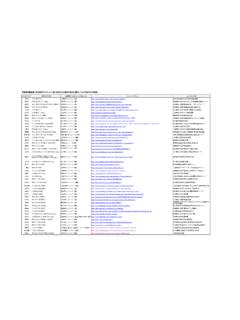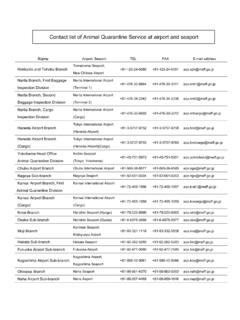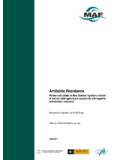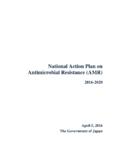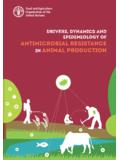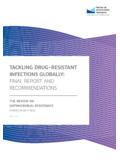Transcription of Report on the Japanese Veterinary Antimicrobial Resistance ...
1 Report on the Japanese Veterinary Antimicrobial Resistance monitoring system -2012 to 2013- National Veterinary Assay Laboratory Ministry of agriculture , Forestry and Fisheries 2016 Contents Introduction ..1 I. The Japanese Veterinary Antimicrobial Resistance monitoring system ..2 1. Objectives ..2 2. Outline of JVARM ..2 (1) monitoring of Antimicrobial Sales ..2 (2) monitoring of Antimicrobial -resistant Bacteria ..3 3. JVARM Implementation system ..3 (1) monitoring system in farm ..3 (2) monitoring system in slaughterhouses.
2 3 4. Quality Assurance/Quality Control Systems ..4 5. Publication of II. An Overview on the Availability of Veterinary Antimicrobial Products in Japan used for Therapy or Growth Promotion ..6 III. monitoring of Antimicrobial Resistance ..9 1. monitoring system in farm ..9 (1)Escherichia coli ..9 (2) 10 (3)Campylobacter .. 10 (4) 11 2. monitoring system in slaughterhouses .. 16 (1)Escherichia coli .. 16 (2) 17 (3) Campylobacter .. 17 (4) 18 IV. JVARM Topics .. 19 Decreasaed Resistance to broad-spectrum cephalosporin in Escherichia coli isolated from healthy broilers by voluntary withdrawn of ceftiofur.
3 19 V. Current Risk Management of Antimicrobial Resistance Linked to Antimicrobial Products 20 VI. JVARM Publications .. 26 VII. Acknowledgments .. 27 VIII. Participants in the JVARM program .. 28 IX. Appendix (Materials and Methods) .. 30 1. Sampling .. 30 2. Isolation and Identification .. 30 3. Antimicrobial Susceptibility Testing .. 31 4. Resistance Breakpoints .. 32 5. Statistical analysis .. 32 p33- Table 2 Distribution of MICs and Resistance (%) in Escherichia coli isolates from animals (2012-2013) Table 3 Distribution of MICs and Resistance (%) in Enterococcus faecalis isolates from animals (2012-2013) Table 4 Distribution of MICs and Resistance (%) in E.
4 Faecium isolates from animals(2012-2013) Table 5 Distribution of MICs and Resistance (%) in Campylobacter jejuni isolates from animals (2012-2013) Table 6 Distribution of MICs and Resistance (%) in C. coli isolates from animals(2012-2013) Table 7 Distribution of MICs and Resistance (%) in Salmonella isolates from animals (2012-2013) Table 8 Salmonella serovars isolated from food-producing animals (2012-2013) 1 Introduction Antimicrobial agents are essential for the maintenance of health and welfare in animals as well as humans.
5 However, the use of antimicrobials can be linked to the emergence and increasing prevalence of Antimicrobial -resistant bacteria. The impact on human health has been a concern since Swann et al. reported that Antimicrobial -resistant bacteria arising from the use of Veterinary Antimicrobial agents were transmitted to humans through livestock products, which consequently reduced the efficacy of Antimicrobial drugs in humans. In addition, the development of Antimicrobial Resistance in bacteria of animal origin reduces the efficacy of Veterinary Antimicrobial drugs.
6 Antimicrobial agents have been used for prevention, control, and treatment of infectious diseases in animals worldwide, and for non-therapeutic purposes, such as growth promotion in food-producing animals in some countries, including Japan. In Japan, the Japanese Veterinary Antimicrobial Resistance monitoring system (JVARM) was established in 1999 in response to international concern over the impact of Antimicrobial Resistance on public and animal health. The JVARM program conducted preliminary monitoring for Antimicrobial -resistant bacteria in 1999, and the program has operated continuously since this initial surveillance was conducted.
7 Veterinary Antimicrobial use is a selective force for the appearance and prevalence of Antimicrobial -resistant bacteria in food-producing animals. However, Antimicrobial -resistant bacteria are also found in the absence of Antimicrobial selective pressures. The trends in Antimicrobial Resistance in zoonotic bacteria and in indicator bacteria from healthy food-producing animals, and Antimicrobial sales volume under the JVARM program from 2012 to 2013, are outlined in this Report .
8 References Swann, 1969. Report of the joint committee on the use of antibiotics in animal husbandry and Veterinary medicine. HM Stationary Office. London. Tamura, Y. 2003. The Japanese Veterinary Antimicrobial Resistance monitoring system (JVARM) In: Bernard, V. editor. OIE International Standards on Antimicrobial Resistance . Paris, France: OIE (World organisation for animal health); 2003. pp 206-210. 2 I. The Japanese Veterinary Antimicrobial Resistance monitoring system 1. Objectives The objectives of JVARM are to monitor both the occurrence of Antimicrobial Resistance in bacteria in food-producing animals and the sales of antimicrobials for animal use.
9 These objectives allow the efficacy of antimicrobials in food-producing animals to be determined, prudent use of such antimicrobials to be encouraged, and the effect on public health to be ascertained. 2. Outline of JVARM JVARM comprises three components (summarized in Figure 1) 1) monitoring the sales volume of antimicrobials used for animals, 2) monitoring Resistance in zoonotic and indicator bacteria isolated from healthy animals, and 3) monitoring Resistance in animal pathogens isolated from diseased animals.
10 All bacteria were isolated from food-producing animals on farms until 2011. In order to enhance monitoring , samples were also collected in slaughterhouses starting in 2012. Outline of JVARM (1) monitoring of Antimicrobial Sales The monitoring implementation system of Antimicrobial sales volume is shown in Figure 2. Pharmaceutical companies that produce and import antimicrobials for animals are required to submit data to the National Veterinary Assay Laboratory (NVAL) annually in accordance with The Act on Securing Quality, Efficacy, and Safety of Pharmaceuticals, Medical Devices, Regenerative and Cellular Therapy Products, Gene Therapy Products, and Cosmetics (Law , Series of 1960).



